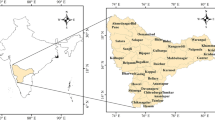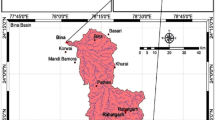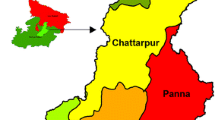Abstract
Drought is one of the most severe natural disasters caused due to water scarcity, causing an adverse impact on an area's agriculture and water resources. The occurrence of drought depends on the amount, duration and frequency of rainfall. In this study, the SPI-12 time series was calculated using average rainfall over the basin for 69 years. It was observed that there was a total of 21 drought events in the Tons basin, i.e., once in every three years. Maximum rainfall departure was observed for the year 1965 with a value of − 39.4%. An extreme drought event of 24 months was observed from June 2009 to May 2011 with severity of − 39.3 and mean intensity of − 1.6. Spatial vulnerability to drought calculated by using various geospatial layers was used for this purpose: elevation zones, soil type, land use land cover, population density, distance from river reach, slope, depth to groundwater level, and drought frequency map. These layers were prepared and overlaid using a geographic information system to form a composite map of the Drought Vulnerability Index (DVI) to depict the spatial vulnerability of drought. The DVI map showed that 18.2%, 42.4%, and 37.9% of the total basin area fall under moderate, severe, and critical vulnerability zones. Rewa, Satna, Mirzapur and Sonbhadra districts were found to be under the severely vulnerable category. This methodology provides essential information to decision-makers to identify the critical areas susceptible to drought and formulate the mitigation plan to minimize the damage to the economy.










Similar content being viewed by others
References
Ahmadalipour, A., & Moradkhani, H. (2018). Multi-dimensional assessment of drought vulnerability in Africa: 1960–2100. Science of the Total Environment, 644, 520–535.
Amrit, K., Pandey, R. P., & Mishra, S. K. (2018a). Characteristics of meteorological droughts in northwestern India. Natural Hazards, 94(2), 561–582.
Amrit, K., Pandey, R. P., Mishra, S. K., & Daradur, M. (2018b). Relationship of drought frequency and severity with range of annual temperature variation. Natural Hazards, 92(2), 1199–1210.
Antwi-Agyei, P., Fraser, E. D., Dougill, A. J., Stringer, L. C., & Simelton, E. (2012). Mapping the vulnerability of crop production to drought in Ghana using rainfall, yield and socio-economic data. Applied Geography, 32(2), 324–334.
Center for International Earth Science Information Network - CIESIN - Columbia University. (2018). Gridded Population of the World, Version 4 (GPWv4): Population Density, Revision 11. Palisades, NY: NASA Socioeconomic Data and Applications Center (SEDAC). https://doi.org/10.7927/H49C6VHW. Accessed 28 March 2021.
Dabanli, I. (2018). Drought hazard, vulnerability, and risk assessment in Turkey. Arabian Journal of Geosciences, 11(18), 1–12.
Dalezios, N. R., Blanta, A., Spyropoulos, N. V., & Tarquis, A. M. (2014). Risk identification of agricultural drought for sustainable agroecosystems. Natural Hazards and Earth System Sciences, 14(9), 2435–2448.
Das, J., Gayen, A., Saha, P., & Bhattacharya, S. K. (2020). Meteorological drought analysis using Standardised Precipitation Index over Luni River Basin in Rajasthan, India. SN Applied Sciences, 2(9), 1–17.
Dayal, D., Gupta, P. K., & Pandey, A. (2021). Streamflow estimation using satellite-retrieved water fluxes and machine learning technique over monsoon-dominated catchments of India. Hydrological Sciences Journal, 66(4), 656–671.
Ekrami, M., Marj, A. F., Barkhordari, J., & Dashtakian, K. (2016). Drought vulnerability mapping using AHP method in arid and semi-arid areas: A case study for Taft Township, Yazd Province, Iran. Environmental Earth Sciences, 75(12), 1–13.
Guha-Sapir, D., Vos, F., Below, R., & Ponserre, S. (2012). Annual disaster statistical review 2011: the numbers and trends.
Gupta, V., & Jain, M. K. (2018). Investigation of multi-model spatiotemporal mesoscale drought projections over India under climate change scenario. Journal of Hydrology, 567, 489–509.
Gupta, V., Kumar Jain, M., & Singh, V. P. (2020). Multivariate modeling of projected drought frequency and hazard over India. Journal of Hydrologic Engineering, 25(4), 04020003.01.
Hao, Z., Singh, V. P., & Xia, Y. (2018). Seasonal drought prediction: Advances, challenges, and future prospects. Reviews of Geophysics, 56(1), 108–141.
Hoque, M. A. A., Pradhan, B., & Ahmed, N. (2020). Assessing drought vulnerability using geospatial techniques in northwestern part of Bangladesh. Science of the Total Environment, 705, 135957.
Jain, V. K., Pandey, R. P., & Jain, M. K. (2015). Spatio-temporal assessment of vulnerability to drought. Natural Hazards, 76(1), 443–469.
Ji, L., & Peters, A. J. (2003). Assessing vegetation response to drought in the northern Great Plains using vegetation and drought indices. Remote Sensing of Environment, 87(1), 85–98.
Kumar, N., Singh, S. K., Singh, V. G., & Dzwairo, B. (2018). Investigation of impacts of land use/land cover change on water availability of Tons River Basin, Madhya Pradesh, India. Modeling Earth Systems and Environment, 4(1), 295–310.
Kundu, A., Dutta, D., Patel, N. R., Denis, D. M., & Chattoraj, K. K. (2021). Evaluation of Socio-Economic Drought Risk over Bundelkhand Region of India using Analytic Hierarchy Process (AHP) and Geo-Spatial Techniques. Journal of the Indian Society of Remote Sensing, 1–13.
McKee, T. B., Doesken, N. J., & Kleist, J. (1993). The relationship of drought frequency and duration to time scales. In Proceedings of the 8th Conference on Applied Climatology (Vol. 17, No. 22, pp. 179–183).
Meshram, S. G., Gautam, R., & Kahya, E. (2018). Drought analysis in the tons River Basin, India during 1969–2008. Theoretical and Applied Climatology, 132(3), 939–951.
Mishra, A. K., & Singh, V. P. (2010). A review of drought concepts. Journal of Hydrology, 391(1–2), 202–216.
Mishra, V., Tiwari, A. D., Aadhar, S., Shah, R., Xiao, M., Pai, D. S., & Lettenmaier, D. (2019). Drought and famine in India, 1870–2016. Geophysical Research Letters, 46(4), 2075–2083.
Naumann, G., Barbosa, P., Garrote, L., Iglesias, A., & Vogt, J. (2014). Exploring drought vulnerability in Africa: An indicator based analysis to be used in early warning systems. Hydrology and Earth System Sciences, 18(5), 1591–1604.
NBSS & LUP. (1996). Soils of Madhya Pradesh for optimizing land use. National Bureau of Soil Survey & Land Use Planning Technical Bulletin No. 24, Nagpur, India.
Oikonomou, P. D., Tsesmelis, D. E., Waskom, R. M., Grigg, N. S., & Karavitis, C. A. (2019). Enhancing the standardised drought vulnerability index by integrating spatiotemporal information from satellite and in situ data. Journal of Hydrology, 569, 265–277.
Pai D. S., Latha Sridhar, Rajeevan M., Sreejith O. P., Satbhai N. S., & Mukhopadhyay B. (2014). Development of a new high spatial resolution (0.25° X 0.25°). Long period (1901–2010) daily gridded rainfall data set over India and its comparison with existing data sets over the region; MAUSAM, 65(1), 1–18.
Pandey, R. P., Pandey, A., Galkate, R. V., Byun, H. R., & Mal, B. C. (2010). Integrating hydro-meteorological and physiographic factors for assessment of vulnerability to drought. Water Resources Management, 24(15), 4199–4217.
Pandey, S., Pandey, A. C., Nathawat, M. S., Kumar, M., & Mahanti, N. C. (2012). Drought hazard assessment using geoinformatics over parts of Chotanagpur plateau region, Jharkhand, India. Natural hazards, 63(2), 279–303.
Parsons, D. J., Rey, D., Tanguy, M., & Holman, I. P. (2019). Regional variations in the link between drought indices and reported agricultural impacts of drought. Agricultural Systems, 173, 119–129.
Rahmati, O., Falah, F., Dayal, K. S., Deo, R. C., Mohammadi, F., Biggs, T., & Bui, D. T. (2020). Machine learning approaches for spatial modeling of agricultural droughts in the south-east region of Queensland Australia. Science of the Total Environment, 699, 134230.
Safavi, H. R., Esfahani, M. K., & Zamani, A. R. (2014). Integrated index for assessment of vulnerability to drought, case study: Zayandehrood River Basin, Iran. Water Resources Management, 28(6), 1671–1688.
Saha, S., Kundu, B., Paul, G. C., Mukherjee, K., Pradhan, B., Dikshit, A., & Alamri, A. M. (2021). Spatial assessment of drought vulnerability using fuzzy-analytical hierarchical process: A case study at the Indian state of Odisha. Geomatics, Natural Hazards and Risk, 12(1), 123–153.
Shah, D., & Mishra, V. (2020). Integrated Drought Index (IDI) for drought monitoring and assessment in India. Water Resources Research, 56(2), e2019WR026284.
Shahid, S., & Behrawan, H. (2008). Drought risk assessment in the western part of Bangladesh. Natural Hazards, 46(3), 391–413.
Spinoni, J., Naumann, G., Carrao, H., Barbosa, P., & Vogt, J. (2014). World drought frequency, duration, and severity for 1951–2010. International Journal of Climatology, 34(8), 2792–2804.
Spinoni, J., Barbosa, P., Bucchignani, E., Cassano, J., Cavazos, T., Christensen, J. H., & Dosio, A. (2020). Future global meteorological drought hot spots: A study based on CORDEX data. Journal of Climate, 33(9), 3635–3661.
Swain, S., Mishra, S. K., & Pandey, A. (2020). Assessment of meteorological droughts over Hoshangabad district, India. In: IOP Conference Series Earth and Environmental Science, 491, 012012. IOP Publishing.
Swain, S., Mishra, S. K., & Pandey, A. (2021a). A detailed assessment of meteorological drought characteristics using simplified rainfall index over Narmada River Basin, India. Environmental Earth Sciences, 80(6), 1–15.
Swain, S., Mishra, S. K., Pandey, A., & Dayal, D. (2021b). Identification of meteorological extreme years over central division of Odisha using an index-based approach. In Hydrological Extremes (pp. 161–174). Springer, Cham.
Swain, S., Patel, P., & Nandi, S. (2017). Application of SPI, EDI and PNPI using MSWEP precipitation data over Marathwada, India. In: 2017 IEEE International geoscience and remote sensing symposium (IGARSS), pp. 5505–5507.
Thakur, P. K., Garg, V., Kalura, P., Agrawal, B., Sharma, V., Mohapatra, M., Kalia, M., Aggarwal, S. P., Calmant, S., Ghosh, S., Dhote, P. R., Sharma, R., & Chauhan, P. (2020). Water level status of Indian reservoirs: A synoptic view from altimeter observations. Advances in Space Research, 68, 619–640.
Thilakarathne, M., & Sridhar, V. (2017). Characterisation of future drought conditions in the Lower Mekong River Basin. Weather and Climate Extremes, 17, 47–58.
Thomas, T., Jaiswal, R. K., Galkate, R. V., & Nayak, T. R. (2016). Reconnaissance drought index based evaluation of meteorological drought characteristics in Bundelkhand. Procedia Technology, 24, 23–30.
Tian, L., Yuan, S., & Quiring, S. M. (2018). Evaluation of six indices for monitoring agricultural drought in the south-central United States. Agricultural and Forest Meteorology, 249, 107–119.
Wang, P., Qiao, W., Wang, Y., Cao, S., & Zhang, Y. (2020). Urban drought vulnerability assessment–A framework to integrate socio-economic, physical, and policy index in a vulnerability contribution analysis. Sustainable Cities and Society, 54, 102004.
Wilhelmi, O. V., & Wilhite, D. A. (2002). Assessing vulnerability to agricultural drought: A Nebraska case study. Natural Hazards, 25(1), 37–58.
Wilhite, D. A., & Glantz, M. H. (1985). Understanding: The drought phenomenon: The role of definitions. Water International, 10(3), 111–120.
Yaduvanshi, A., Srivastava, P. K., & Pandey, A. C. (2015). Integrating TRMM and MODIS satellite with socio-economic vulnerability for monitoring drought risk over a tropical region of India. Physics and Chemistry of the Earth, Parts A/b/c, 83, 14–27.
Yuan, X. C., Wang, Q., Wang, K., Wang, B., Jin, J. L., & Wei, Y. M. (2015). China’s regional vulnerability to drought and its mitigation strategies under climate change: Data envelopment analysis and analytic hierarchy process integrated approach. Mitigation and Adaptation Strategies for Global Change, 20(3), 341–359.
Zeng, Z., Wu, W., Li, Z., Zhou, Y., Guo, Y., & Huang, H. (2019). Agricultural drought risk assessment in Southwest China. Water, 11(5), 1064.
Acknowledgements
The authors are thankful to the Indian Space Research Organisation (ISRO) for providing financial support during the study period. We are also grateful to the Department of Water Resources Development and Management (WRD&M), IIT Roorkee, for providing resources to conduct the research work.
Author information
Authors and Affiliations
Corresponding author
Ethics declarations
Conflict of interest
The authors declare that they have no conflict of interest.
Additional information
Publisher's Note
Springer Nature remains neutral with regard to jurisdictional claims in published maps and institutional affiliations.
About this article
Cite this article
Kalura, P., Pandey, A., Chowdary, V.M. et al. Assessment of Hydrological Drought Vulnerability using Geospatial Techniques in the Tons River Basin, India. J Indian Soc Remote Sens 49, 2623–2637 (2021). https://doi.org/10.1007/s12524-021-01413-7
Received:
Accepted:
Published:
Issue Date:
DOI: https://doi.org/10.1007/s12524-021-01413-7




